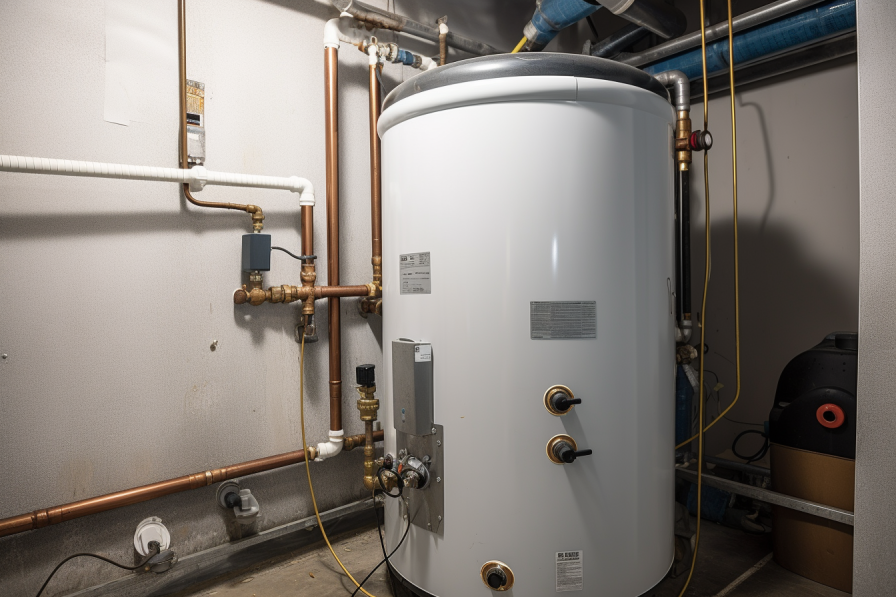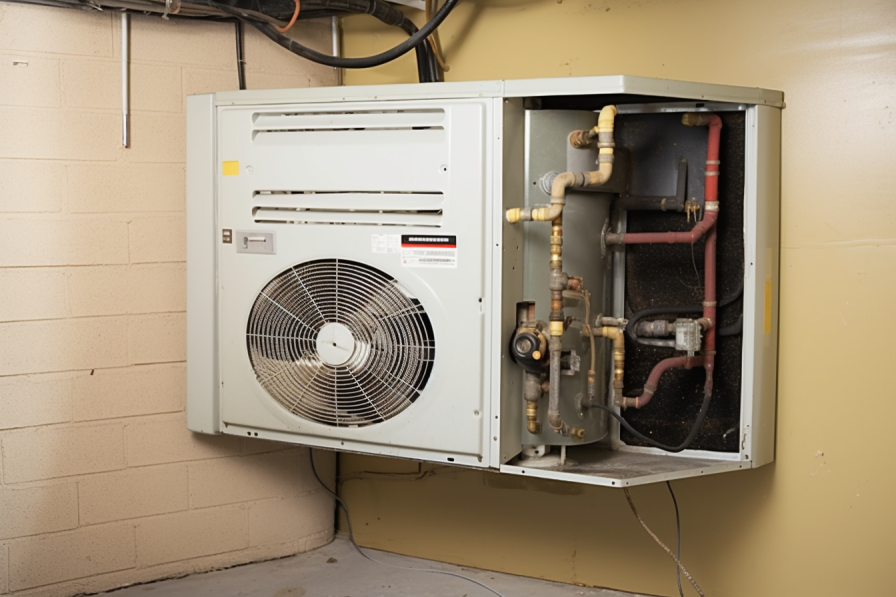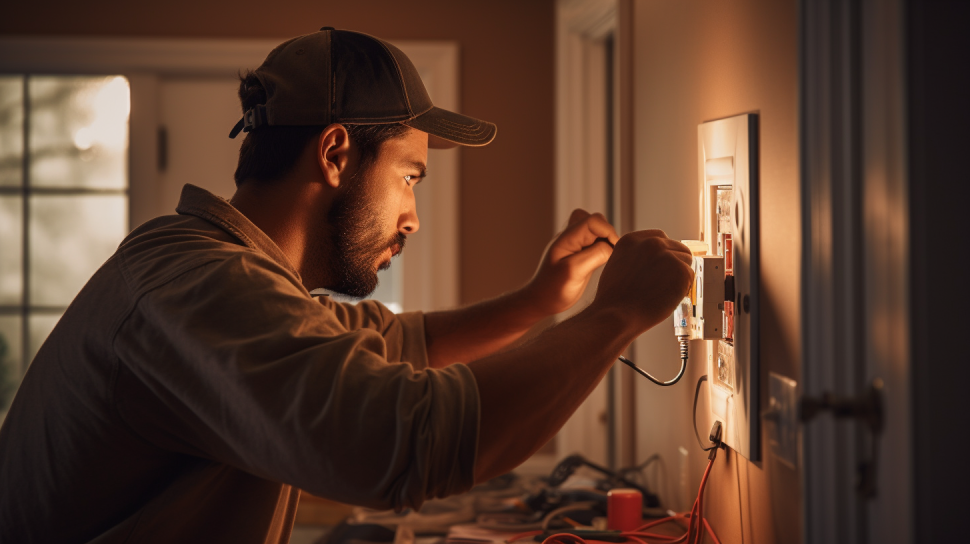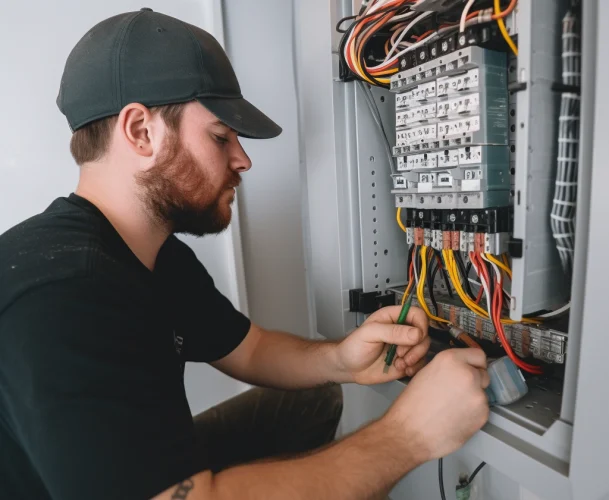In the world of electrical wiring, there's a specific type for almost every application you can think of, and 10/2 wire is a staple in many residential and commercial projects.
A 10/2 wire consists of two conductors: a black wire (hot), a white wire (neutral), and an additional bare wire used as the ground. Its name reflects its characteristics: '10' denotes the wire gauge, which correlates to the wire's diameter, and '2' refers to the number of insulated conductors within the cable.
Understanding when and where to use 10/2 wire requires a bit of electrical system knowledge. It's often used for circuits that require up to 30 amperes of current, such as water heaters, dryers, and large window air conditioners.
These applications are commonly found in households that demand a significant amount of power. The thickness of 10 gauge wire is ideal for carrying the higher current needed by these appliances safely.
Key Takeaways
- We use 10/2 wire for various residential and commercial applications.
- This type of wire is suitable for heavy loads that use 30-amp circuits such as those for water heaters and large air conditioners.
- Our understanding of electrical systems helps us apply 10/2 wire safely and effectively.

Understanding 10/2 Wire Basics
Before we dive into the nitty-gritty, let's acknowledge a simple truth: when we're working with 10/2 wire, we're dealing with a robust insulated wire that's designed for certain electrical applications. From its gauge to the number of conductors, each attribute plays a pivotal role in its utility.
Gauge Wire Characteristics
10 AWG is a specific size in the wire gauge system that signifies the diameter of the wire. Here's a straightforward point: the smaller the gauge number, the thicker the wire. A 10-gauge wire handles more current than a 12-gauge wire – to be exact, it's typically rated for amperage of up to 30 amps.
Number of Conductors and Their Purpose
Our 10/2 wire comprises two conductors plus a ground wire. It's essential for us to know that these conductors are responsible for carrying electricity to and from the power source. This kind of wire is often used in applications that do not require a neutral wire.
Insulation and Jacketing Explained
Safety first, right? The insulation material and jacket surrounding the conductors is very much needed. Typically, you'll find PVC as the insulation material in 10/2 wires.
The jacket, which is also made of durable materials like PVC, is there to protect the wire from environmental damage and to ensure our safety. Plus, a UL Listed mark on the wire signifies that it meets safety standards.
Remember, when choosing wire, it’s critical to understand these safety issues to ensure that it fits the electrical needs and adheres to building codes.
Applications of 10/2 Wire
When we talk about 10/2 wire, we're really focusing on its uses in places where a significant amount of power is needed. Thanks to its ability to handle up to 600 volts and amperages up to 30 amps, this type of wire is quite versatile.
Common Residential Uses
For our homes, we rely on 10/2 wire in a few key areas. In the kitchen, the power demands can be hefty—think electric wall heaters, which can eat up to 30 amps.
On top of that, heavy-duty appliances like some dryers and built-in single ovens also rely on this type of wire to ensure we don't run into any supply issues.
- Kitchen: Appliances such as ovens and dryers often use 10/2 wire due to high power requirements.
- Heating: Electric wall heaters may require 10/2 wire for proper ampacity.
Commercial and Outdoor Applications
Stepping outside the home, 10/2 wire shows its versatility. For commercial settings, we find this wire in equipment that's pulling a lot of juice, where lower gauge wires just won't cut it.
Similarly, for outdoor setups like patios, 10/2 wire is often used for AC units because it can stand up to the elements—whether it's dry or wet—thanks to its insulation and ampacity.
- Equipment: Vital in supplying power to more demanding commercial equipment.
- AC Units: Ideal for outdoor use due to durability, even in patios exposed to various weather conditions.

Electrical System Compatibility
When we're talking about 10/2 wire, it's necessary to match its capabilities with the needs of our electrical systems. Let's break down how it lines up with voltage and amperage requirements.
Voltage Ratings and Capacity
Voltage is a measure of the pressure from an electrical circuit's power source that pushes charged electrons through a conducting loop, enabling them to do work such as powering equipment.
The 10/2 wire is typically rated for a capacity of up to 600 volts, but for most residential applications, it's commonly used for circuits requiring 240 volts. This makes it a solid choice for hooking up heavy-duty appliances that demand a higher voltage, ensuring compatibility with a wide range of equipment in both home and some commercial settings.
Understanding Amperage and Load
The term amperage refers to the flow of electric current through a wire. In the case of 10/2 wire, it's about knowing its carrying capacity. We can typically expect a 10/2 wire to handle up to 70 amps.
This translates to a robust capacity for most larger household appliances and tools, which makes it especially useful where the electrical system needs to accommodate higher currents.
When sizing our wires, we have to ensure that the amperage we're dealing with doesn't exceed the carrying capacity of the wire to avoid overheating and potential hazards.
Safety and Regulations
When we talk about using 10/2 wire, it's key to focus on following safety measures and regulations closely. This ensures our electrical systems are efficient, safe, and up to code. Let's dive into what that entails.
National Electrical Code Compliance
The National Electrical Code (NEC) sets the foundation for electrical safety in residential, commercial, and industrial occupancies. For 10/2 wire, which contains two conductors of 10 American Wire Gauge (AWG), the NEC provides rules to determine the correct breaker size, which is crucial for preventing overloads and potential hazards.
Compliance with NEC Article 240 involves using the right breaker for your panel to match the wire's amperage, which for a 10/2 wire is typically up to 70 amps.
Local Codes and Standards
While the NEC offers a benchmark, local electrical codes may have additional requirements. It's our responsibility to ensure that any electrical work with 10/2 wire adheres to these local standards. These might dictate conduit size, wire fill capacity, and even the types of fixtures that can be used.
It’s essential we check with our local building authority for the specific stipulations in our area to guarantee we're not overlooking any critical mandates.
Electrician's Role in Ensuring Safety
Professional electricians play a pivotal part in maintaining electrical safety. Their expertise is necessary for interpreting the NEC and local requirements, choosing the right materials, and ensuring proper installation.
We trust our electrical systems with 10/2 wire will not only meet legal standards but also function safely for the intended applications. It's a collaborative effort to keep our wiring safe and structurally sound.
Installation Considerations
When we're getting ready to work with 10/2 wire, it's critical for us to consider a few key aspects to ensure safety and the wire's performance over time. These include how we run the wire, account for voltage drop, and manage special wiring scenarios.
Proper Techniques for Running Wire
We need to make certain that we're using the correct methods when we run 10/2 wire. It's a two conductor cable typically including a hot, neutral, and a ground wire (safety wire), which makes it ideal for specific installations.
Here's what we keep in mind:
- Cable Support: Secure the cable to framing with wire staples every 4 to 6 feet.
- Cable Protection: Use conduit or cable armor if the wire runs through areas where it could get damaged.
Factors Impacting Voltage Drop and Longevity
A few factors greatly influence both voltage drop and the longevity of our wire:
- Length of Run: The longer the wire span, the more resistance, which can cause voltage drop. Keep runs as short as possible to minimize this.
- Ambient Temperature: In hotter environments, the wire temperature can rise, increasing resistance and potentially causing a drop in voltage.
Here's a quick reference for you:
| Span (feet) | Recommended Wire Size | Voltage Drop |
|---|---|---|
| Up to 100 | 10/2 wire | Minimal |
| 100-150 | Upsize cable | Moderate |
| 150+ | Consult a professional | Significant |
Special Cases: Underground and Outdoor Wiring
For outdoor or underground installations, we opt for a cable type that’s suitable for the environment:
- Outdoor: 10/2 wire should have a UV-resistant jacket and be rated for wet locations if it’s exposed.
- Underground: We use UF (underground feeder) cable, which is specifically designed to be buried without needing conduit for protection.

Physical and Technical Features
In this section, we'll look at the physical characteristics and technical specifications of 10/2 wire to understand its makeup and capabilities.
Conductor Colors and Identification
10/2 wire features a pair of conductors: one black, signifying a hot wire, and one white, which serves as the neutral wire. Identification is simple with these standard colors, ensuring proper connection. Each wire is covered in PVC (polyvinyl chloride) insulation.
Wire Size and Insulation Types
The "10" in 10/2 wire represents the wire size, which is 10-gauge, reflecting its diameter and current-carrying capacity, also known as ampacity. PVC insulation protects these conductors. It’s robust enough to handle the electrical load and is standard for both residential and commercial use.
Cable Ratings and Electrical Properties
When it comes to electrical properties, 10/2 wire is suitable for up to 30 amps of current, typically at voltages of 120V or 240V. The cable also houses a ground wire, which enhances safety by providing a pathway for fault currents.
Here's a quick look at its ratings:
- Voltage Rating: Up to 240V
- Ampacity: Typically 30 amps (may vary with insulation type and temperature)
10/2 wire’s physical and electrical characteristics make it ideal wire for air conditioners units where safety and efficiency are critical.
Practical Tips for Handling 10/2 Wire
When we're working with 10/2 wire, it's crucial to handle it properly for a safe and efficient installation. Cutting and stripping the wire correctly and making secure connections are the main tasks we'll cover.
Measuring and Cutting to Length
First up, we need to measure the wire accurately. Always account for a bit of extra wire to make your connections—that can save us from the headache of a wire that's too short.
- Measure the desired length.
- Mark the point for cutting on the wire's insulation.
- Use a wire cutter to cleanly snip through.
- Ensure a straight cut for the best results.
Stripping Insulation and Connecting to Devices
Next, we'll strip the insulation without damaging the conductor inside:
- Use a wire stripper to remove about ¾ inch of insulation from the wire's end.
- Twist the stripped conductor slightly to prevent fraying.
For connecting it to devices:
- Switches and outlets: Use screw terminals rated for 10-gauge wire. If they aren’t, we might need to pigtail to a smaller gauge that's compatible.
- Connecting to pumps: Ensure the connectors are suited for the electrical current the pump will draw.
- For charge flow consistency, connect the black (hot) wire to the brass screw and the white (neutral) to the silver screw.
- Secure the wire under the connector's screws and tighten to maintain a good flow of electrical current without overheating issues.
Remember, before working with any wires, always ensure the power is off to prevent any flow of current, and always follow local code requirements for electrical installations.
Comparison with Other Wire Types
Before we dive into the details, let's clarify that wire types are categorized by the number of conductors and gauge size. When comparing 10/2 wire to 10/3 wire or choosing between copper wire and aluminum, we're dealing with specific applications and safety considerations.
10/2 Wire versus 10/3 Wire
10/2 Wire
- Contains one hot wire (typically black), one neutral wire (white), and a ground wire (bare or green).
- Suitable for 240V circuits.
- Devices like mini splits with a 240V requirement benefit from this setup.
10/3 Wire
- Contains two hot wires (black and red), one neutral wire (white), and a ground wire (bare or green).
- Appropriate for 208/230V circuits.
- Provides an extra conductor for setups requiring an additional hot wire, like some mini split systems.
In practice, if we're working with systems that need a 240V circuit, we'll opt for 10/2 wire. But if an appliance demands a more complex setup with an extra hot conductor, necessitating 208/230V, then 10/3 is our go-to.
When to Choose Aluminum over Copper
Here's where we get to talk materials:
Aluminum
- It's lightweight and less costly than copper.
- Best for heavy-duty applications where weight and budget are considered.
Copper
- Known for its superior conductivity and durability.
- Preferred in most residential wiring scenarios for its reliability.
We'll lean towards aluminum when cost savings are a priority and the application can handle the slight trade-off in conductivity. For the majority of our home electrical wiring, however, we stick with copper for its longevity and minimal resistance.
Final Thoughts
10/2 wire serves as a necessary component in residential and commercial electrical systems, offering reliability and safety for high-power applications.
Understanding its specifications and applications is vital for ensuring efficient and compliant installations.
For professional assistance and free estimates, contact Bates Electric, where our expertise guarantees your electrical needs are met with precision and care.
Give us a call for a FREE estimate.
Frequently Asked Questions
We've got all the nitty-gritty details on 10/2 wire, so if you're scratching your head about this stuff, we're here to clear things up.
How many amps can 10-gauge wire handle safely?
10-gauge wire, which is what we have in 10/2 wire, can typically handle up to 30 amps safely. But remember, different conditions like temperature can affect ampacity.
What are the common uses for 10/2 wire in residential wiring?
We use 10/2 wire pretty often for major home appliances that run on 240 volts, like water heaters, dryers, and some air conditioning units.
Is there a difference in applications between 10/2 and 10/3 wires?
Sure is! The main difference comes down to the extra conductor in 10/3 wire—it's what we'd choose for circuits that need a neutral, like a dryer, while 10/2 works great for simpler 240-volt appliances without a neutral requirement.
Can I safely run a 220V circuit using 10/2 wire?
Yep, you can run a 220V circuit with 10/2 wire, as long as the current draw is within the safe ampacity of the wire—typically up to 30 amps. Always check local codes and appliance requirements, though.
What's the maximum distance 10/2 wire can be run for a 30-amp circuit?
The max distance we can run 10/2 wire without worrying about voltage drop is generally about 150 feet. Beyond that, you might need thicker wire to keep things efficient and safe.
What should I consider when purchasing 10/2 wire for a home project?
When we're grabbing 10/2 wire for a project, we consider the specific electrical needs of the appliance, conduit sizing, local electrical codes, and future-proofing our work. Make sure it matches the specs for your gig to avoid any hiccups with inspections, too.



